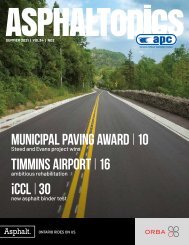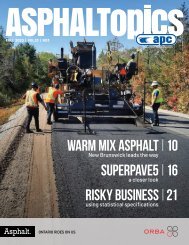ASPHALTopcs | Summer 2017 | VOL 30 | NO 2
You also want an ePaper? Increase the reach of your titles
YUMPU automatically turns print PDFs into web optimized ePapers that Google loves.
transfer areas in the composite<br />
pavement structure, the solution<br />
to the voids was to drill 11,000 holes<br />
to inject grout under pressure below<br />
the concrete. In addition, 6,600 steel<br />
dowel bars were installed to help<br />
transfer the load between the<br />
concrete slabs.<br />
“The slots for the dowel bars<br />
required specialized machinery,<br />
so we contracted Randy Cole of<br />
Cole Concrete Cutting in Wyoming,”<br />
Carinci says. “This company has one<br />
of three machines in the U.S. that can<br />
do this work. It was critical that Cole’s<br />
equipment be used from April 1 to<br />
the 17. Equipment in Canada can<br />
only make <strong>30</strong>0 slots per day, whereas<br />
Cole’s machine made 900 and had<br />
a capacity of 1,200 slots per day.”<br />
Runway 05-23 runs east-west and<br />
is 3,<strong>30</strong>0 metres long by 61 metres<br />
wide. Once the concrete repair work<br />
was complete, 20,000 tonnes of<br />
PGAC 64-28 lower course asphalt<br />
was laid. The surface course asphalt<br />
required 50,000 tonnes of PGAC<br />
70-28 polymer-modified asphalt<br />
cement. Work was staggered for<br />
the rehabilitation of two interacting<br />
runways (15L-33R and 15R-33L), with<br />
three days devoted to each of those<br />
portions of the runway to minimize<br />
disruptions to the runways.<br />
Prior to the application of the surface<br />
course, some areas were padded to<br />
meet the specified longitudinal profile<br />
of the runway. The built-up crown<br />
of the runway has approximately<br />
200 mm of asphalt on top of the<br />
original concrete base, and the<br />
intersecting runways gradually<br />
slope to meet the crown of the<br />
primary 05-23 runway.<br />
“Most of the loads are on the centre<br />
23 metres of the runway, so we didn’t<br />
do a lot of work on the concrete<br />
outside of this area,” says Kevin<br />
Chee, Senior Civil Engineer for GTAA.<br />
“There is 200 mm of asphalt at the<br />
centre of the runway at 1,000 metres<br />
in length on the west end, because<br />
testing showed the greatest number<br />
of voids in this location. There is<br />
hardly any load at the edges of the<br />
runway, so these sections only had<br />
a 65 mm asphalt overlay.”<br />
Excavation work ran day and night,<br />
while concrete pours and asphalt<br />
paving work occurred during the<br />
day. Echelon paving of the runway<br />
surface course took place in just 10<br />
days, with one steady 60 mm thickness<br />
for the surface pavement. Each of six<br />
pavers paved five metre swaths for the<br />
centre <strong>30</strong> metres of the runway. The<br />
base asphalt was carried out by four<br />
paving crews, while the surface asphalt<br />
required six paving crews, four shuttle<br />
buggies, 40 trucks and two asphalt<br />
plants producing a total of 8,000<br />
tonnes of asphalt per day.<br />
“It was important not to have any cold<br />
joints at the wheel path of aircraft, so<br />
the job required echelon paving with<br />
six pavers for the centre <strong>30</strong> metres ››<br />
SUMMER <strong>2017</strong> 13

















